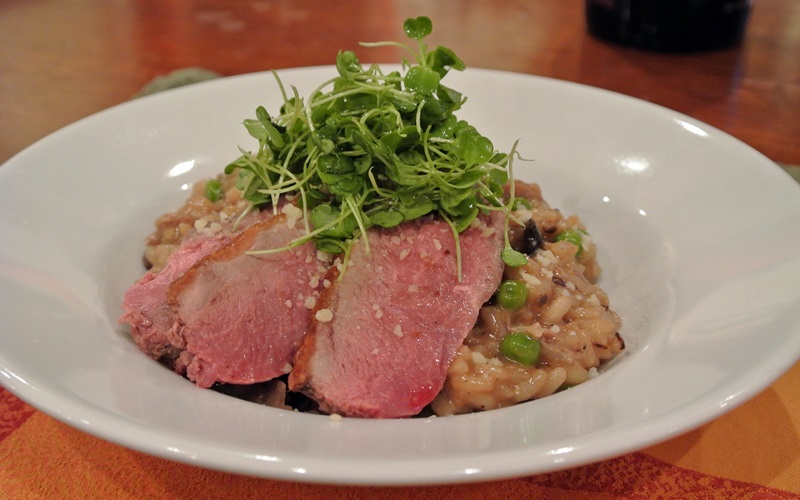
Duck is slightly tricky to cook, but a classic risotto makes matters easy. Duck legs need to be cooked long and slow (think duck confit). But for duck breasts, you must slowly render out the duck fat from the skin and then quickly sear it to a medium-rare. In both cases, the duck fat released is gold!
This recipe makes 8 servings. The duck legs will take about 2 hours to prep before you can start the risotto.
Ingredients and directions:
- 2 duck legs
- 2 duck breasts
- 8 cups chicken stock (preferably home-made)
- 1 medium onion – chopped to a medium dice
- 2 cups arborio rice
- 1 cup dry white wine
- 4 ounces of pitted black oil-cured olives – cut in half
- ½ pound frozen peas, defrosted
- ½ cup grated Parmesan cheese with extra for serving on top of the risotto
- Baby arugula or micro greens and your favorite vinaigrette
- Rinse the duck legs under cold water and pat dry with paper towels. Sprinkle with a little salt and pepper all over.
- Using a medium sauce pot, place over medium-high heat. Add the duck legs and brown all over. Add the stock to the pot with the duck legs. Bring to a boil and then immediately reduce to a simmer over low to medium-low heat. Cover and simmer for about 1 ½ hours or until the meat is falling off the duck leg.
- Remove the duck legs from the broth and allow to cool enough so you can handle them. Then shred the duck meat off the legs, reserving in a bowl. Discard the duck skin and bones. Keep the broth hot over a medium-low heat. This is the stock to be used with the risotto, and infused with the duck fat from the legs it is liquid gold!
- Score the skin of the duck breasts with a cross-hatch pattern using a sharp knife. Using a second heavy-bottomed pot over medium-low heat, lay the duck breast skin-side down and slowly render the fat. This will take about 20 minutes. Don’t rush it, because you’ll just seal in the fat and the breasts will taste flabby.
- Once most of the fat is rendered out, turn the heat up to medium-high and crisp the duck skin. Then turn over and cook the duck for 1 minute to brown. Remove the duck breasts to a plate and tent with aluminum foil.
- Now comes a big question: the duck fat left in the pot is the gold but too much duck fat will produce a greasy mouth-feel. I recommend you leave just the amount of duck fat in the pot that is equivalent to a few tablespoons of olive oil that you’d use to sauté the onions. Remove the unused fat to a container for another use.
- Over medium heat, add the diced onion and sauté until soft – about 5 minutes. Add the rice and stir occasionally until the rice begins to turn opaque.
- Add the white wine and stir into the rice until it mostly evaporates.
- Now begin adding the hot chicken-duck stock one ladle at a time. Add a ladle and then stir until the stock is absorbed into the rice. Continue adding the stock, one ladle at a time, until the rice becomes creamy but still a little “al dente” – about 30 minutes.
- About 5 minutes before the rice is done, add the torn meat from the duck leg, the peas and the olives. Also add cheese. Stir into the risotto until the peas are soft.
- Thinly slice the duck breast as shown in the photo.
- Assemble the risotto by placing a ladle-full of the risotto in the center of a bowl. Top with a little more cheese. Lean 3 or so slices of the sliced duck breast against risotto. Then quick toss your greens with the vinaigrette, top of the risotto with this nice green pop – and serve!
